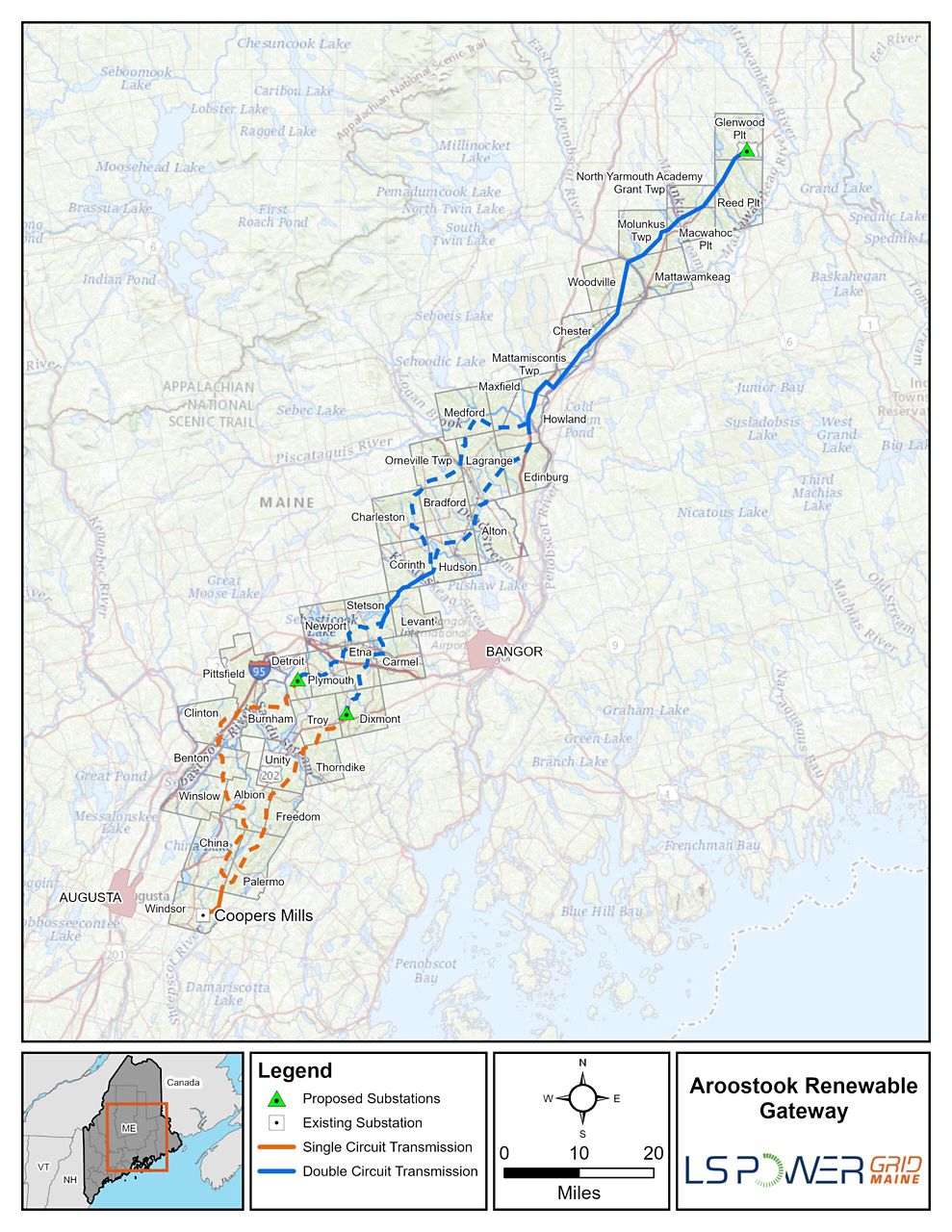Just before the July Fourth holiday, Greg Rossel and his neighbors got a letter in the mail telling them their properties may be impacted by a new power corridor stretching from Aroostook County to Kennebec County.
A Missouri company called LS Power sent the letter to explain their approximately 150-mile-long transmission line project to bring electricity generated by wind power to the New England grid.
At first, Rossel threw the letter in the recycling bin. It looked like the mailers that often arrive in Mainers’ mailboxes, asking them to sign up for renewable power programs.
Rossel, a boatbuilder who lives in Troy, gets most of his power from the solar panels on his workshop roof. He wasn’t interested in another solicitation.
But then a neighbor called, prompting him to dig the letter out.
“I’ve been following that project, and nowhere did it ever say where they were going to be running this corridor,” he said. “In my wildest dreams I never thought it would be here.”
He feels blindsided.
The letter indicates the project “may impact property that you own depending on the route chosen.”
Doug Mulvey, a vice-president with LS Power, said the company is considering several routes for the project and that they are “very early in the process.”
They sent letters to 3,500 to 4,000 people to invite them to public meetings this week and next so they can explain the project. So far, 200 people have reached out asking for more information.
“We’ll have very, very detailed maps at these meetings, along with GIS to individual parcels,” he said. “Ultimately, our job is to consider feedback and come up with the best route for the transmission line.”
The map Rossel received in the mail shows the line starting in Glenwood Plantation in Aroostook County heading south until it ends in the Kennebec County town of Coopers Mills. There are dotted lines that show alternatives, including the one that runs through Troy where Rossel lives.

The letter indicates the line could extend to a substation in Wiscasset in Lincoln County, depending on the “final project scope.”
Mulvey said once they settle on a single route, they will go back to the Public Utilities Commission for approval. If the route gets the go-ahead, they will approach landowners in hopes of negotiating a voluntary easement at fair market value.
“We work very hard to keep facilities 300 feet away from homes,” he said. “We don’t intend to take any homes.”
He said once they have PUC approval for the route, they will have the power of eminent domain, which he described as a “truly last resort.”
The project has bipartisan support from the highest levels of state government, with Senate President Troy Jackson (D-Allagash), Senate Minority Leader Trey Stewart (R-Presque Isle) and Gov. Janet Mills, a Democrat, all on board.
Jackson said the project has been in the works for more than two years going through what he described as “a very open process.”
“I understand people’s concerns, I do,” he said. “I wouldn’t want anything jammed through. If something like this was going through my backyard, I would be concerned also. This was not something we wrote in stone.”
But the project, which began in 2021 with the PUC asking for companies to bid on a northern Maine transmission route, is vital to helping the state reach its goals to reduce the impacts of climate change, Jackson said.
Uncertainty about the route and other questions prompted some Republicans to oppose Jackson’s bill last month that sought legislative approval of the project.
“First, I’d like to know the impact on Maine ratepayers, with specificity,” Sen. Rick Bennett (R-Oxford) said. “Secondly, where is the route? To do our jobs of oversight as required by statute, legislators should demand answer to questions.”
On Tuesday, the company attempted to answer Bennett’s first question by releasing a study they commissioned projecting that Maine ratepayers will save an estimated $887 million over the life of the project contracts.
In promoting the study, the Maine State Chamber of Commerce said the project promises “vital and meaningful savings” for residents and businesses.
“Our members need lower and more predictable energy prices and the Daymark analysis shows that the average residential customer will save $2.33/month and the average commercial/industrial customer will save nearly $4,700/per month,” said Ben Lucas, senior government relations specialist with the chamber.
Most lawmakers had enough information to support the initiative, passing it by comfortable margins in the House and Senate. Mills signed it into law June 22.
Formally known as the Aroostook Renewable Gateway Transmission Line, the project seeks to bring power from a wind farm in Aroostook County and tie into the regional power grid.
Maine has agreed to pay for 60% of the cost of the project and receive 60% of the power through contracts with Central Maine Power and Versant Power, Mulvey said.
Massachusetts will pick up the other 40% of the cost and benefit.
For many, including Rossel, the project brings to mind Maine’s other large transmission line project, the Central Maine Power corridor that is now moving forward after years of lawsuits and public referendums.
“The state made a wicked mistake with that project up there,” he said. “It could have been operational now if the state was not so intractable.”
Jackson said Aroostook County has been held back for years because it lacks the ability to tap into the steady wind that could be used to reduce the state’s dependence on fossil fuels.
He envisions a project that will create jobs now and open the doors to future economic development with the promise of lower electricity rates for residents and businesses.
“Aroostook County wind blows at night and during the winter, when in other places it’s intermittent,” Jackson said. “This isn’t pie in the sky. We know it’s going to be much cheaper than what we’re paying now.”
Rossel has lived on his property for 50 years and wonders whether the new corridor will disturb a historic cemetery, a deer yard or a stream nearby, not to mention concerns about his home and workshop.
He said other states have demanded that new power lines be buried or run along existing corridors to lessen the visual impact and to protect the power from high wind and heavy snow.
He and his wife Norma plan to attend a meeting in Albion next week to learn more.
“We are now called stakeholders, although I feel like a stake in the heart person,” he said.
LS Power has scheduled meetings from 4-7 p.m. to answer questions from the public, including tonight (July 12) at the Howland Town Office; Tuesday, July 18 at the Etna Town Office; Wednesday, July 19 at the Besse Building in Albion and Thursday, July 20 at the Windsor Fair Grounds Commercial Building in Windsor.





